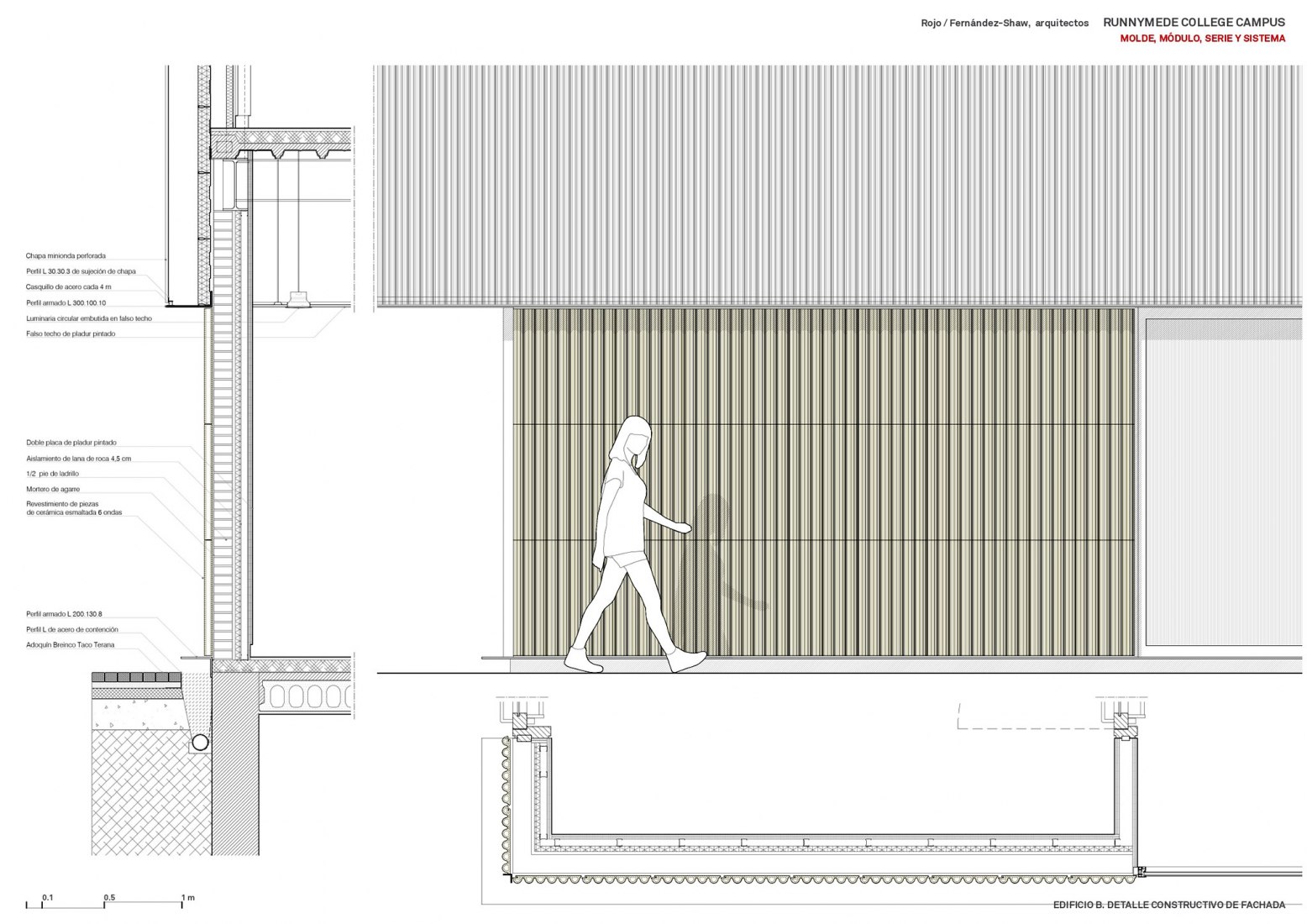The architects propose a space that dialogues, which allows it to satisfy the needs of both students and teachers. Permeability and materiality will be another fundamental aspect of the development of the project. The verticality of the cladding slats stands in sharp contrast to the horizontality of the different prismatic volumes, showing an important visual richness in the architectural language.
Description of project by Rojo/Fernández-Shaw Arquitectos
The Official College of Architects of Madrid has awarded the First COAM Prize and the Luís M. Mansilla Prize 2019 to the architects Luis Rojo de Castro and Begoña Fernández-Shaw Zulueta, for the renovation of AULARIO B FOUNDER'S HALL at the RUNNYMEDE COLLEGE CAMPUS located in the Madrid town of La Moraleja, Alcobendas (Madrid).
“The Founder's Hall / Aulario B, built on three floors from an existing structure and which houses the Classrooms, Laboratories, and Study rooms, takes as a starting point, for reasons of sustainability, the conservation and reuse of a structure that is enlarged by means of a system of light steel trusses that allows the dimensions to be expanded, space opened and natural light introduced inside.”
“Depending on the point of view, the orientation or the time of day, the light and the weather conditions, the volume solidifies at its edges or dissolves. Open and closed, solid and light, opaque and transparent.”
Rojo/Fernández-Shaw Architectos
MOLD, MODULE, SERIES, AND SYSTEM
CERAMICS, A WORKING PROCESS
A CAMPUS revolves around the collective exterior space, central but shapeless, open, and continuous. And, around it, the architecture disperses and dissolves into a set of pavilions and green spaces. An open environment, alien to the rigid order of geometry or alignments, to build the environment of a Campus of knowledge, of an academic space in which order and freedom coexist.
In the Project, new pavilions coexist with renovations that take advantage of existing structures, some built with a new plant and others as extensions and modifications of buildings in use. For this reason, the palette of materials used in the set is intentionally reduced and strategic to provide order and unity.
Each material characterizes a particular environment. Inside, wood, resin, and glass in their different states of transparency give warmth and color to space; On the outside, the glazed ceramic and the corrugated and perforated galvanized sheet introduce the material, texture, and color coherence that link the pieces and pavilions.
In the search for a material with the capacity for adaptation and modular, formal adaptation and in its finish, we have found in vitrified ceramics an extraordinary architectural resource. Due to its flexibility in its formal configuration, its material quality, and its multiple surface qualities, ceramic is the element that accompanies and unifies each need on the Campus, and its presence gives identity and character to the whole.
Under the concept of MOLD / MODULE / SERIES / SYSTEM, we have developed a series of ceramic pieces from a first MOLD, a 7 cm hollow circular tube. diameter. Initially conceived as a free-standing element, capable of forming various lattice surfaces with multiple variations in density and possible modulation, this element is transformed into a MODULE from which other pieces are configured to form a SERIES or SYSTEM, the result of a study of variations dimensional and 2/2 to give a coherent and integrated response to each project need and which originate from the geometry and modulation of the circle of the initial MOLD.
Tube of 7 cm. in diameter by 70 cm. height, made to measure in glazed ceramic, serves as the basis for establishing a common modulation to the entire campus and for designing a working system in which the same piece inspires both an opaque wall and a latticework.
In Building 1, these tubes are hung as a façade thanks to a metallic inner sleeve, establishing a rhythm that adapts to the needs of privacy or transparency. Each tube acquires the total height of the building (3.50 m), standing 12 cm. in front of a glass facade, which it protects and qualifies.
In Building B, the same cylinder acquires the configuration of a surface, forming pieces of 6 modules or waves that line the facades. Establishing a geometric harmony and a modular and dimensional continuity with the corrugated galvanized facade sheet, with which it shares the dimension of the wave. The brightness of the ceramic and that of the galvanized sheet merge into a dimensional and geometric unit, which response to the search for unity and coherence described.
And in the interiors, the ceramic surface flattens its wave without modifying the modulation to create walls of great material and superficial quality, suitable for use in public and collective spaces, such as dining rooms, multipurpose rooms, and lobbies.
















































